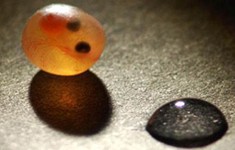 e there are objections worldwide to genetically modified fish, salmon reared to perform better or to have particular characteristics through genetic selection breeding programs are the future of the industry, according to Scottish experts Landcatch.
e there are objections worldwide to genetically modified fish, salmon reared to perform better or to have particular characteristics through genetic selection breeding programs are the future of the industry, according to Scottish experts Landcatch. The company, which produces up to 40 million salmon ova and 4.5 million smolts per year, is owned by Hendrix Genetics, a world leading multi species breeding company. Hendrix has brought the expertise and technology used in the poultry, pig and turkey industry to the salmon rearing business, with impressive results.
Fish can already be selected for particular characteristics including growth, survival, Omega-3 levels and fillet color, and will soon be bred for increased resistance to disease, using genomic selection tools.
The work uses Single Nucleotide Polymorphism (SNP) chips, which are glass slides used to analyze variations in DNA sequences, which act as biological markers and help scientists locate a range of genes associated with disease resistance. Landcatch is planning to market the first eggs — developed from its disease resistance research — by 2014.
Already, the company’s latest development, reduced susceptibility to sea lice infestation, is a particularly exciting one for its customers and means they can look forward to healthier fish and lower mortalities in future. The fish farming industry in Scotland is worth around GBP 500 million (USD 762 million, EUR 592 million) and spends large sums of money fighting the effects of sea lice infestation and fatal diseases such as IPN (infectious pancreatic necrosis) and AGD (amoebic gill disease).
Working at the sharp end of the business is Keith Drynan, head of broodstock production, who explained that all brood fish are kept at a land based seawater site on the West coast of Scotland, in controlled conditions to ensure they are disease free and healthy. “We use new stock each year, making up to 1800 genetic crosses to produce fish with the particular traits required by customers,” said Drynan. All are grown to the Scottish Salmon Producers’ Organization Code of Good Practice standards, and they also meet the standards for Label Rouge, Freedom Food and GlobalGap.
Until 2009, the majority of Landcatch eggs were sold to Chile, but a change in that country’s health regulations stopped the export business overnight, leaving the company to seek new markets in the European salmon industry. It is still involved in Chile however, and provides genetic services and breeding support for more than 25 percent of egg production in Chile, using the Landcatch strain.
Spawning takes place from September to December, and male and female fish are carefully hand-stripped before the milt and eggs are mixed to produce the correct cross. Each clutch of eggs is barcoded to ensure full traceability, then placed in incubators in controlled temperature and environmental conditions.
At 250 degree days they reach the ‘eyed’ stage, at which point they are sorted to remove non-viable eggs then further incubated to around 320 degree days. At this point they are meticulously hand-picked and selected, to ensure that customers receive a premium product.
Eggs are carefully layered into polystyrene cases for delivery, with ice as a top layer to keep them cool and moist during transportation. Packed in this way they remain viable for 4-5 days, giving ample time to reach their destination.
Landcatch hand-delivers each batch, to ensure there are no issues with delivery or quality, then follows up progress of the fish over time.
“We collect growth and health information from customers to help us improve fish performance each year, and the new genetic developments mean that our fish will be even better in future and enable us to make a meaningful contribution to world food security,” said Drynan.





